PSEB 12th Class Physical Education Practical Athletics
Athletics Game History
The origin of athletics has been found in the ancient Greek. The activities of running, jumping, throwing can be traced in the primitive times. Man had to hunt for his survival for which these activities were needed. Sometimes he used to run away from danger. He used stone throwing for killing the animals.
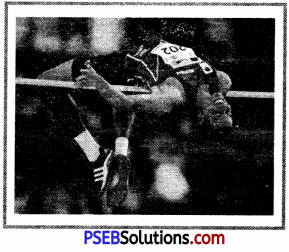
Later these activities took shape of competitive activities. Probably the first foot race took place thousands of years ago as this was described in Greek poem MLLIAD’ which was composed in 700 B.C. In 776 B.C. First Olympic Games were held in Greece where foot race was the only event. Athletics was introduced in England in 11th century. Modem athletics began in England in 1837. In 1896 first modem Olympic Games were held in Athens where athletic events were introduced. In 1912 sixteen countries formed ‘International Amateur Athletic Federation’.
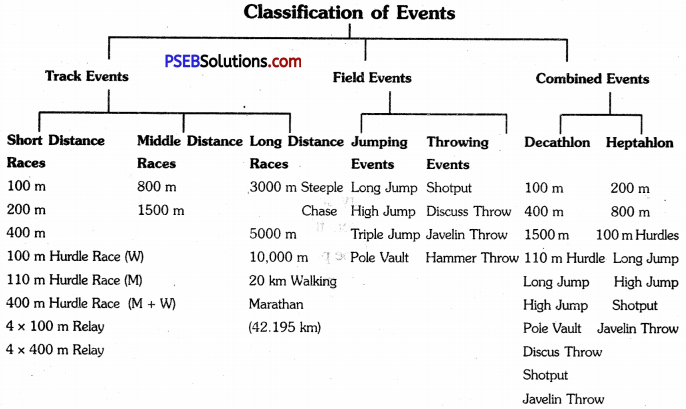
Athletics Game Latest General Rules
1. The start and finish of a race shall be measured from the edge of the starting line farther from the finish to the edge of the finish line nearer to the start.
2. On the command ‘on your marks’ or ‘set’ if competitor fails to comply after a reasonable time, shall constitute a false start.
3. If a competitor starts movement before the shot of the gun, it shall be a false start and disqualified at a very first instance.
4. The time is taken from the fire of the electronic gun to the time when competitor touches his torso with the vertical plane of the nearer edge of the finish line.
5. Every competitor must be provided with two chest numbers which must be worn on the chest and back. Where photo finish equipment is in operation the competitor must wear thigh numbers.
6. In all races run in particular allotted lanes, each competitor shall keep within his own lane.
7. In hurdling, each race has 10 hurdles. The hurdlers must run in their allotted lanes. They are disqualified if they allow their leg to trail along the side of a hurdle. The hurdler is not penalized for knocking down hurdle in his own lane.
8. Starting blocks shall be used for all races upto and including 400 m (including the first leg of the 4 x 200 m and 4 x 400 m) and shall not be used for any other race. When an athlete uses his own starting blocks, they shall comply with rules.
9. Wind Measurement. The periods for which the wind velocity shall be measured from the flash of the starter’s gun or approved starting apparatus are as follows:
- 100 m 10 S
- 100 m Hurdles 13 S
- 110 m Hurdles 13 S
In the 200 m event, the wind velocity shall be measured for a period of 10 seconds commencing when the first athlete enters the straight.
The wind gauge for track events shall be placed beside the straight, adjacent to first lane at 50 m from the finish line. It shall be positioned 1.22 m high and not more than 2 m away from the track.
![]()
Athletics Game Important Points
- Competition Director:01
- Manager:01
- Technical Delegate:01 (or more)
- Technical Manager:01
- Jury of Appeal:03,05 or 07
- Referee for Track Events:01 (or more)
- Referee for Field Events:01 (or more)
- Referee for Combined Events:01 (or more)
- Chief Judge for Track Events:01
- Chief Judge for Field Events:01
- Judges for Track Events:03 (or more)
- Judges for Field Events:03 (or more)
- Chief Judge for Walking Event:01
- Judges for Walking Event:04
- Umpires for Track Events:04 (or more)
- Starter:01 (or more)
- Recaller:01 (or more)
- Starters Assistant:01 (or more)
- Lap Scorer:01 (or more)
- Recorder:01 (or more)
- Marshal:01 (or more)
- Wind Gauge Operator:01 (or more)
- Chief Photo Finish Judge:01
- Assistant Photo Finish Judges:02
- Measure ment Judge:01 (or more)
- Call Room Judge:01 (or more)
- Announcers:02
- Statistician:01 (or more)
- Stewards:01 (or more)
- Doctor:01 (or more)
![]()
Athletics Game Rules And Regulations
Rules for Throwing Events:
1. The order in which the competitors take their trials shall be drawn by lot.
2. When there are more than eight competitors, each competitor shall be allowed three trials. Out of these trials best eight are selected and are given three additional chances. If there is a tie for eighth place, and competitor so trying shall be allowed for two additional trials. Eight or when the number of competitors are less, each competitor is given four trials.
3. At the competition each thrower is given two practice trials.
4. The competitor must not leave the circle until the implement has touched the sector.
Putting The Shot:
- The shot shall be put from the shoulder with one hand only.
- A competitor is allowed to touch the inside of both the iron ring and the stop board.
- Use of gloves is not allowed.
- Shot must fall within the sector.
- Use of adhesives and leather belt is allowed.
- Use of taping is not allowed.
Discus:
- It shall be a foul throw if the competitor touches the ground outside the circle or the top edge of ring if he has begun the technique.
- The discus must fall within the inner edges of the sector.
Rules For Jumping Events
Rules for Long Jump and Triple Jump:
1. The order of trials shall be drawn by lot.
2. When there are more than eight jumpers, each jumper shall be given three trials. Out of these trials best eight are selected and are given three additional chances. If there is a tie for eighth place, any jumper so tying shall be allowed for two additional chances. When the number of competitors is eight or fewer, each competitor is given four trials.
3. A competitor fails if he or she:
- Touches the ground beyond the take off line with any part of his or her body.
- Takes off from side of the take off board.
- While landing or in the course of landing, the jumper touches the ground outside the landing area.
- performs somersaulting.
4. In case of a tie, second best jump is considered. If still tie occurs, the third best is considered and so on.
Rules of High Jump:
1. The order in which the competitors take their trials shall be drawn by lot.
2. Before the competition begins, the chief judge announces the starting height and the subsequent heights to which the bar will be raised at the end of each round. Unless only the one competitor is remaining and the bar should never be raised by less than 2 cm in case of high jump.
3. A competitor fails if after the jump the bar does not remain on the upright bars because, of the action of the competitor.
4. In high jump, competitor must take off from one foot.
5. Once a competition has begun, competitors are not permitted to use the runway area for sake of trials.
6. Two chances are given to clear one height.
![]()
Ties in the High Jump:
1. The competitor with the lowest number of jumps at the height at which the tie shall be … given the higher place.
2. If the tie still remains, the competitor who is having less failure throughout the event and including last height cleared shall be given the higher place.
3. If the tie still remains and if it is for the first place, the tying competitor shall have one more jump at the lowest height at which any of those involved in the tie failed, and yet if the decision is not final, the bar shall be raised or lowered 2 cm for the high jump. They shall then attempt one jump at each height until tie is resolved.
Measurements of Play Field and Specifications of Equipments
Standard Track:
For all International Championships, the length of the track is 400 m. It has 8 lanes. It consists of 2 straights and 2 bends. The inside of the track is bordered by metallic fencing which is 5 cm in height and 5 cm in width. Each lane is 1.22 m in width.
Dimensions:
In the Budapest congress of the LAAF held in 1966 a little addition was made regarding marking of track and .lanes. This says, “the measurement should be taken 30 cm outward from the inner border of the track dr where no border exists 20 cm from the line marking the inside of the track.”
- Total Distance of Track:400 m
- Straight Distance:84.39 m
- Radius:36.50 m
Stagger:
The stagger is the distance given for each lane to compensate the excess distance which is increased due to the increase in radius of each line.
Formula for calculating staggers:
[w(n-1)-10 cm] 2 π
- w-stands for width of lane
- n-stands for number of lanes for which stagger is calculated
- π -it is a constant and is equal to 22/7.
The distance of the staggers for the 200 m and 400 m race:
| 200 m | 400 m | |
| 1st Lane | 0.00 m | 0.00 m |
| 2nd Lane | 3.52 m | 7.04 m |
| 3rd Lane | 7.35 m | 14.71 m |
| 4th Lane | 11.19 m | 22.38 m |
| 5th Lane | 15.02 m | 30.05 m |
| 6th Lane | 18.86 m | 37.71 m |
| 7th Lane | 22.69 m | 45.38 m |
| 8th Lane | 26.52 m | 53.05 m |
![]()
Staggers for 800 m race:
The staggers for 800 m race consists of staggers for 200 m+Diagonal excess. The calculation for the runner in the first lane doesn’t arise as he will be running in the lane throughout the first lap. The diagonal distance by the runner in the second lane is very negligible and is not considered.
The distance of staggers for 800 m race
| 1st Lane | 0.00 m |
| 2nd Lane | 3.52 m |
| 3rd Lane | 7.37 m |
| 4th Lane | 11.26 m |
| 5th Lane | 15.15 m |
| 6th Lane | 19.09 m |
| 7th Lane | 23.02 m |
| 8th Lane | 26.97 m |
Specification of Hurdle. The following are the dimensions of the hurdle:
Men:
| Distance of race | Height of hurdle | Distance from start line to first hurdle | Distance between hurdles | Distance from last hurdle to finish line |
| (Metres) | (Metres) | (Metres) | (Metres) | (Metres) |
| 110 | 1.067 | 13.72 | 09.14 | 14.02 |
| 400 | 0.914 | 45.00 | 35.00 | 40.00 |
Women:
| Distance of race | Height of hurdle | Distance from start line to first hurdle | Distance between hurdles | Distance from last hurdle to finish line |
| (Metres) | (Metres) | (Metres) | (Metres) | (Metres) |
| 100 | 0.840 | 13.00 | 08.50 | 10.50 |
| 400 | 0.762 | 45.00 | 35.00 | 40.00 |
Construction:
The hurdles are made of metal and wood. They consist of 2 feet and 2 uprights. The uprights are fixed on the end of each base. The height of the hurdle is adjustable.The hurdle shall be of such a design that a force at least equal to the weight of 3.6 kg applied to the centre of the top edge of the bar is required to overturn it.
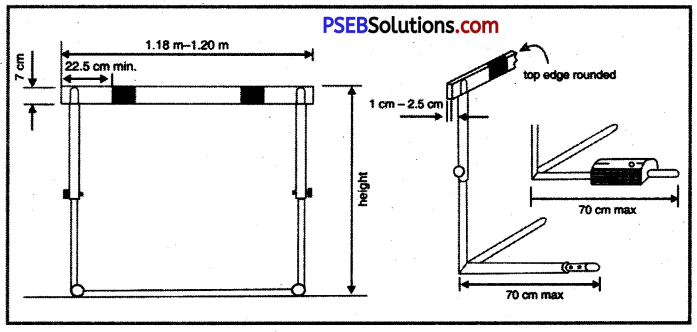
Construction of Baton:
The baton is made up of hollow metallic tube which shall not be more than 30 cm and not less than 28 cm in length. The circumference of the baton shall be from 12 cm to 13 cm. Each baton should weigh 50 gm. It should be bright coloured so that it is easily visible during race.
![]()
Shot Put:
Construction of Shot The shot shall be of solid iron, brass or any other metal not softer than brass.
Specifications of Shot:
| Shot | Men | Women |
| Weight | 7.265 – 7.285 kg | 4.005 – 4.025 kg |
| Diameter | 110 -130 mm | 95-110 mm |
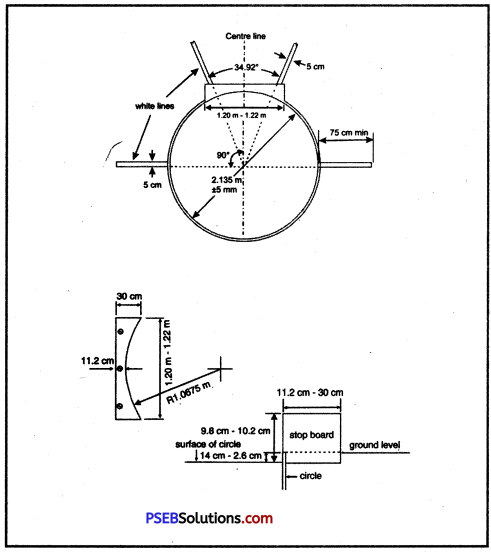
Specifications of Discus:
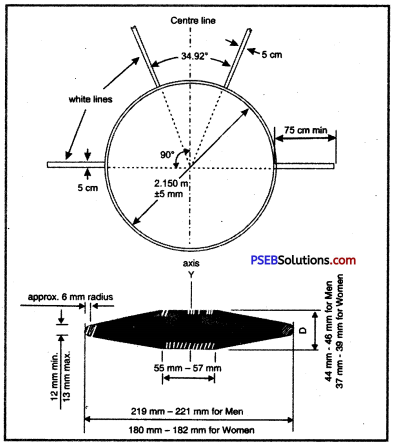
Specifications of Javelin Throw:
| Javelin | Men | Women |
| Weight | 805-825 gm | 605-625 gm |
| Length | 260-270 cm | 220-230 cm |
| Length of Metal Head (Nail) | 250-330 mm | 250-330 mm |
| Distance from Tip of Metal to C.O.G. | 90-100 cm | 80-95 cm |
| Diameter of Shaft | 25-30 mm | 20-25 mm |
| Width of Cord | 150-160 mm | 140-150 mm |
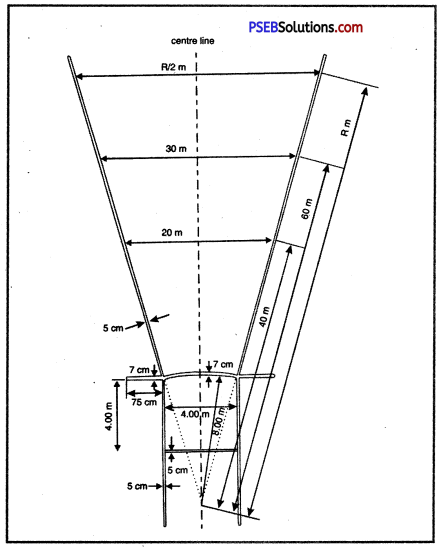
Specifications of Long Jump:
The Runway:
The minimum length of the runway shall be 40 m. The width of runway should be from 1.22-1.25 m. It is marked with 4 cm wide white lines.
Take off Board:
It is placed 1 m from the nearer end of the landing area. It is made up of wood and measures 1.22 m x 20 cm x10 cm (depth).
Plasticine Indicator Board:
It is mounted in line to the edge of take off board which is nearer to the landing area. It measures 1.22 m x 10 cm x 7 mm (height). The edges shall either slant at 45° and are covered by 1 mm thick plasticine layer.
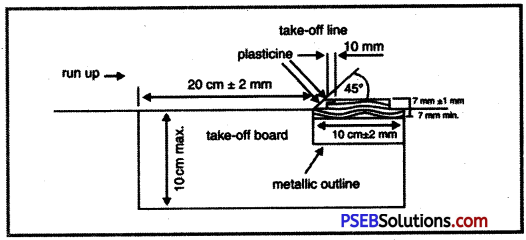
Landing Area:
The landing area should have minimum width of 2.75 m and maximum of 3 m, the length of the landing area is 9 m. It is filled with the soft damp sand.
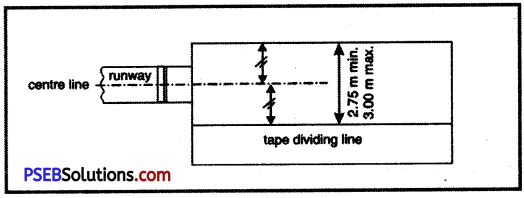
Specifications of Triple Jump:
All the specifications of pit, take off board and plasticine indicator board are same as in jump. But the takeoff board along with the plasticine indicator should not be less than 13 m for men and 11 m for women from the nearer end of the landing area.
![]()
Specifications of High Jump:
Runway: The minimum length of runway shall be 15 m.
Uprights: Aluminium movable uprights having distance between 4.00 – 4.04 m are allowed. Crossbar. It is made of fibre glass, metal or other suitable material weighing 2 kg. The length of cross bar should be 3.98 – 4.02 m.
Landing Area:
The landing area is rectangular measuring not less than 5 m x 3 m. The landing area should be of foam to avoid injury while landing.
Fundamental Skills:
Track Events
The Start:
The athlete must take good start for having a good chance of winning a sprint. A good start can be defined as coming out of starting blocks off quickly with maximum thrust. To break inertia of rest quickly, the sprinter is crouched before the start because crouching of base makes the body unstable before the start. The crouch start has mainly three parts:
1. Bunch or Bullet Start: In this type of start, the distance between blocks of the starting block varies from 15 to 27 cm. Generally knee of rear leg is aligned with the toe of the front foot.
2. Medium Start: In this start the distance between blocks of the starting block is 40 to 50 cm and the knee of rear leg is aligned with the arch of the front foot.
3. Elongated Start: This type of start is rarely used. The distance between blocks of the starting block varies from 55 to 65 cm. The knee of rear leg is aligned with the heel of the front foot.
Setting of Blocks:
The distance between the blocks is first adjusted according to the type of the start to be used. A sprinter having tall body must fix starting block 21″ from the starting line, however short statured athlete might fix starting block 18″ away from the starting line. In 100 m start the starting block is fixed in the middle and parallel to the lane. While the starting block is fixed along the tangent of the inner curve if the start of the race is starting from a curve. The starting block is fixed on the track with the help of two nails.
On Your Marks Position”
After hearing the command on your marks the athlete comes from behind the blocks. The athlete is advised to place his strong foot first in front and then his rear foot at the back. After placing both the feet in the starting block the athlete should place his hands in front of starting line in such a way that the thumb and first finger makes a bridge. Hands should be kept apart according to the shoulder width. The head should be in line with the body.
‘Set’ Position:
The most important position in the crouch start is the ‘set’ position. After the command ‘set’ the athlete should raise his hips slightly higher than the head and shoulder. After raising hips the body weight must be shifted in front. The eyes should be focused on lane about 3 to 4 feet away from starting line. At ‘set’ position the angles of front knee and rear knee should be around 90° and 120° respectively.
![]()
‘On Fire’:
The athlete should begin running immediately after the pistol is fired. The thrust is taken with the help of front foot and the rear leg comes out first. While driving rear leg, opposite arm is also given a swing in backward direction so that the coordination of arms and legs is maintained right from the beginning of the race.
Note: For long distance races, covering more than 800 m the command ‘set’ is eliminated and race is started with the rest of the two commands.
Finish:
At the ‘finish’, the ‘finishing tape’ should be of wool so that it breaks easily. The finish of the race is not considered with touching of tape but when the torso of an athlete just touches the vertical plane arising out from inner edge of the finish line and this vertical plane is aligned with the finishing tape. The finishing of the race is done in the following methods:
1. Lunge:
Most of the athlete use lunge style while finishing the race. Generally, experienced athletes use this method. In this method athlete lunges ahead with his head and chest. This activity is fastened with the help of backward arm swing. While performing lunge finish an athlete must maintain his body balance.
2. Shoulder Shrug:
In this technique when the athlete comes nearer to the finishing tape, he performs shrugging action. The body is twisted in such a way that the torso makes 90° angle with finish line. This can be achieved by shrugging the opposite shoulder in respect to the forward leg.
3. Running through the Tape:
Most of the beginners use this technique during finish of the sprint. The athlete is advised not to perform any finishing technique and he crosses the finish line without breaking speed and in a natural sprinting action.
Hurdle Races:
Hurdling began about 130 years back. In early times the hurdle races were performed with hurdles which were fixed on ground. At that time many runners got injury because they failed to clear the obstacle. Today hurdles are not fixed on the ground. Even knocking or falling of the hurdle doesn’t disqualify as it takes a fair amount speed out of his sprinting.
Technique of Hurdling:
Take off and flight, over the hurdle are most important requisites of a good hurdling.
As and when athlete approaches the hurdle, the first step is taken off by heel-ball and toe- action. After the take off, the legs are stretched in such a way that they make 90° angle with the hurdle. When the hurdler approaches he should flex his upper body towards the leg. At this stage rear leg should be flexed at 90°. While performing this action the coordination between arms and legs is maintained. After this landing is done with the front leg which is approximately 4 feet from the hurdle.
Relay Races:
4 x 100 m and 4 x 400 m sprint relays are the two most usual races. These relay races are run by four athletes by passing a baton among them.
Technique:
The baton can be exchanged in two ways:
1. Non-Visual Method. This method is used in 4 x 100 m relay race. In this method the athlete changes the baton without seeing back. The baton is changed in change over zone, which is 20 cm long. The first athlete keeps baton in right hand because he is to run on inner side of the curve. The 2nd runner stands in acceleration zone and starts running as the first runner approaches towards him. The non visual method is further divided in two parts:
(i) Upward Pass:
In this method the outgoing athlete should make cup shape fingers at the time of exchange and incoming athlete moves baton in an upward direction. As the baton touches the outgoing athlete’s hand the incoming athlete leaves the baton.
(ii) Downward Pass:
In this technique the outgoing athlete opens hand facing palm upward, the incoming athlete passes baton from downward pass.
2. Visual Method:
This technique is used in longer relay races. The outgoing athlete looks back and starts running. He takes the baton from incoming athlete with watching the movements of incoming athlete.
Field Event:
The field events are measured by the distance and height. They include throwing and jumping events.
Shot put:
Technique: Most of the throwers use either glide or the spin technique. Every thrower starts at the back of the circle facing the back.
![]()
Parry ‘O’ Brian Style:
1. Holding: The shot should rest at the base of fingers. The thumb and little finger first support at the sides.
2. Placement of Shot: The shot should be placed in the clavicle fossa just near to clavicle bone and touching the neck.
3. Stance:
The thrower should stand at the back of the putting circle facing back to the sector. The holding and placement of the shot is done after entering the circle. In case of right-hander, the thrower should flex his left leg and should raise flexed left arm.
4. T-formation:After the stance the thrower should bend his trunk down and to keep the balance left leg is extended.
5. Kick and Glide:
After making T of the body, the left leg is crouched and kick and glide is done to gain momentum. The glide should be long enough to reach the stop board.
6. Delivery:
When the left foot touches the stop board simultaneously the thrust from wrist, arm, shoulder and trunk is taken for putting the shot at 45° angle.
7. Follow Through:
After putting the shot die thrower should make a reverse flick by legs to prevent falling forward.
Disco Put Style:
In this method the movement of shot is circular. Instead of linear momentum, angular momentum is generated. Holding, stance, delivery and follow through is same as in Parry ‘O’ Brian style. But the difference is only in the turning. Thrower has to complete lVi-PA rounds putting the shot.
In the rotational style, the athlete stands upright, facing back to the putting circle. The upper body is turned towards right so that body weight shifts to right. After this the weight is again shifted to left foot. The left knee turns away from the right knee. The right foot in contact with the circle is preferred as long as possible. After the swing, right foot lands on the ball of the foot and right leg continues inward rotation. The left foot is grounded as quickly as possible at the front of circle. At this stage the chest of the thrower faces opposite to throwing direction. Like this the shot is released. After releasing shot, the left leg should swing anti-clockwise so that athlete continues to rotate back into the putting circle.
![]()
Discus:
Technique:
1. Holding the Discus:
The throwing hand is placed on the top of the discus so that the fingers are spread and also pushes over the edge. The wrist is kept rigid and the palm is flat against the surface of discus.
2. Stance: The athlete stands at the back of circle facing back to the direction of throw.
3. Swing:
The thrower makes the initial swings slowly, the speed is generated so that the right arm is fully extended and the discus comes behind the right hip. The height of the discus should be around at shoulder height.
4. Turns:
After achieving full swing the thrower pivots on the left foot with sweeping action of right leg. The thrower reaches the middle of the circle and lands right foot. After landing on right foot, the left leg is extended to the front of the circle. The weight is shifted to left leg.
5. Delivery: The discus is released at the shoulder height with fully extended arm.
6. Follow Through:
After the release of discus the right foot is moved in the front and simultaneously left leg is lifted to the backward reverse flick.
![]()
Javelin Throw:
Technique:
1. Holding: The javelin is held at the cord grip in three ways.
2. Standing Position: The javelin is held above the shoulder pointing forward and almost horizontal.
3. Approach Run:
After the initial stance athlete runs forward keeping the body in slightly leaning forward position. The athlete usually runs 36 metres and achieves 75% of speed. When the thrower is just four strides away from scratch line, the javelin is taken back. During this action athlete maintains the speed and places his feet in front of his body weight. The right knee is lifted and simultaneously push of the left leg is taken. This crossing action of legs in the air leans back the body.
4. Throwing Position:
The right foot is grounded first on the heel. As soon the body weight passes over the right foot and then the weight is shifted to left leg. This action arches the body like a bow. The right shoulder drives up and helps in throwing the javelin. The javelin is released high over the shoulder.
5. Follow Through:
After releasing javelin, the athlete takes one more stride so that the right foot land in front of scratch line. To stop forward movement, hopping is done on the right foot. .
Long Jump:
Technique-
The distance covered in a long jump depends upon the speed and angle of projection at the take off. A long jumper must acquire maximum speed before hitting the take off board.
1. Approach Run:
The athlete starts the run-up from the check mark. An odd number of strides is used s o that maximum speed is achieved. The approach mn should be so long so that strong foot exactly comes on the take off board. Generally top male jumpers take about 23 strides whereas top female athletes take about 17 strides.
2. Take Off:
The take off should be taken exactly from the take off board with vertical lift and at maximum horizontal range and to reach an effective landing position.
3. The Flight:
The aim of flight is to increase horizontal range and reach an effective landing position.
4. Hitch Kick Action:
In this the jumper takes additional stride in the air and cycles the legs. It is called as IV2 hitch whereas highly trained jumpers take another stride given a 2Vi hitch.
5. Hang Style: In this style the body is arched like a bow in the air. It is explained in the given figure.
6. Landing:
The landing must be made with the feet together and ahead of the body. The arms are moved back. After landing, side way falling is preferred to avoid the backward falling.
![]()
Triple Jump:
Technique-
It is also known as Hop, Step and Jump.
1. Approach Run: The check mark is placed so that athlete arrives take off board accurately with maximum acceleration.
2. Take off for Hop:
In this phase body is kept upright. The thighs are driven high and this leg drive is coordinated by action of opposite arm. During this phase the athlete lands the same foot from which he took off.
3. Step:
After the landing from hop, again step is taken but with increased height. Forward action of free leg and arms help the body in driving ahead. In this the jumper takes off from the same step and lands on the other foot.
4. Jump:
After taking step the jumper drives upward into the air vigorously. During this maximum height is achieved. Both arms are moved in forward to help vigorous arm swing.
5. Landing: The landing must be made with the feet together ahead of body same as in long jump.
High Jump:
Technique-
Hie technique of high jump devel oped many times. The following techniques were used:
(i) Scissor Style
(ii) Western Roll
(iii) Straddle Style
(iv) Fosbury Flop
The last two techniques are used now-a-days but fosbury is most advantageous and accepted.
Straddle Style:
In this method the take off foot is nearest to the bar. The jumper goes over facing the bar and lands on the other foot.
1. Approach Run:
Five to nine strides are taken to enable the jumper to get as much speed as required. The running is done at about 35°-45° to the bar.
2. Take-off:
The last stride should be long. The take off foot should touch the take off point in heel ball toe action. During the take off arms should swing upwards. The free leg is given swing above the head.
3. Action in Air:
After taking off the free leg and same side arm will cross the bar first together with head. As the body comes over the bar the take off leg is given kick in upward direction to clear the bar.
4. Landing: In straddle style the landing is done on shoulders or back depending upon the torque.
![]()
Fosbury Flop:
This method is widely used in the world. It is most advantageous because centrifugal forces are utilised in this style.
1. Approach Run: Usually 7-9 strides are taken, straight running is done in curve as the athlete approaches the bar.
2. Take-off:
The foot is planted at least two feet from the cross bar. The jumper must run tall with high. Aggressive knee drive is taken towards the bar. Simultaneously arm swing from both the arms is taken.
3. Action in the Air:
The knees are semi flexed. This results in the hips and thighs being held up. After the hips clear the bar, the legs are straightened so that it helps in lifting the legs away from the bar.
4. Landing: The landing is done on the shoulders in the landing area.
Important Terminologies:
- Pentathlon: It consists of five events competition and is held in one day only.
- Heptathlon: It consists of seven events competition for women held in two days.
- Decathlon: It consists often events competition for men and is held in two days.
- Stagger: It is the distance given for each lane to compensate the excess distance increased due to increase in radius.
- Hurdle: These are the events in which competitor run over obstacles which are called hurdles.
- Steeple Chase: It is the event comprising of 3000 metres distance with two type of obstacles.
- Marathon: It is a long distance race run for 42.195 kilometres. .
- Torso: It is a part of body excluding arms, feet, legs, hands, head and neck.
- Pegging: When the nail of the javelin touches the ground, it is called pegging.
- Putting: In shot put event the putting refers to throwing behind the line of shoulder.
- Sector: Area for valid throw.
- Baton: A baton is 30 cms long metallic hollow pipe which is used in relay races.
- Exchange Zone: The exchange of baton takes place within 20 metres long zone and is called exchange zone.
- Scratch Line: In javelin throw, the thickness of line is 7 cms which is called scratch line.
- Relay: It is a race covered by four runners.
- Foss Burry Flop: It is a technique of high jump in which the centrifugal force is utilized.
- Photo Finish: Instrument used to decide the finish of the race.
![]()
Athletics Game Important Tournaments
International Level:
- Europa Cup: Six Nation Championship held in Europe began in 1965
- World Athletics Championship
- Olympics: Athletics started in 1896
- Commonwealth Games: Athletics started in 1930
- IAAF Grand Prix
- Asian Games: Athletics started in 1951
- Asian Grand Prix
- Asian Track and Field Championship: started in 1973
Nationaf Level:
- National Circuit Meets
- Federation Cup for Seniors
- Federation Cup for Juniors.
Sports Personalities:
Arjuna Award Winners-
- 1966-B. S. Barua
- 1967-Bhim Singli
- 1967-Praveen Kumar
- 1968-ManjiWalia
- 1968-Joginder Singh
- 1969-HarnekSingh
- 1970-Mohinder Singh Gill
- 1971-Edward Sequcira
- 1972-Vijay Singh Chauhan
- 1973-SriramSingh
- 1974-Shivnath Singh
- 1974-T. C. Yohaiman
- 1975-V. Anusuya Bai
- 1975-Han Chand
- 1976-GeetaZuishi
- 1976-Bahadur Singh
- 1978-79 Angel Mary Joseph
- 1978-79 Sureh Babu
- 1979-80 R. Gyanasekaran
- 1980-81-Gopal Sami
- 1981-SabirAli
- 1982-Charles Borromeo
- 1982-Chand Rara
- 1982-M. D. Valsamma
- 1983-P.T.Usha
- 1983-Suresh Yadav
- 1984-Shiny Abraham
- 1984-Raj Kumar
- 1985-Raghubir Singh Bal
- 1985-Asha Agarwal
- 1985-AdiUe Sumariwala
- 1986-Suman Rawat
- 1987-Vandana Shanbagh
- 1987-Bagicha Singh
- 1987-Vandana Rao
- 1987-Balwinder Singh
- 1988-Athwmi Nachappa
- 1989-Moecy Kuflii
- 1990-Lcaa Rn
- 1992-Habair Praad
- 1993-K. Sawnma
- 1994-Ra Kufty
- 1995-Malathi Kriihnamirthy Holla (Para Athlete)
- 1995-Jyotirmoyee Sikdar
- 1995-Sbakli Siagh
- 1996-Par1mm 1baa
- 1997-AjffBhta
- 1996-Ka11cgowi (Para Athlete)
- 1997-M. Mahadrva (Para Athlete)
- 1997-Rccth Abraham
- 1998-P.rami Singli
- 1998-kachila Miatiy
- 1998-SD,EahaI
- 1998-Nerlam Jarwarn &ngh
- 1998-Siridiand Ram
- 1999-Guiab Charal
- 1999-G. Venk avampçla (P.r. Athlete)
- 1999-Gcmt Ku.
- 1999-Panhiniar, Singti
- 1999-Sunita Rani
- 2000-Joginder Singh Bedi (Para Athlete For Lifetime Contribution)
- 2000-Yadvendra Vashishta (Para Athlete)
- 2000-K. M. Beenamol
- 2001-K.R. Shankar Iyer (Para Athlete)
- 2002-Anju Bobby George
- 2002-Saraswati Saha
- 2003-Madhuri Saxena
- 2003-Soma Biswas
- 2004-Devendra Jhajharia (Para Athlete)
- 2004-J. J. Shobha
- 2004-Anil Kumar
- 2005-Manjit Kaur
- 2006-K. M. Bin
- 2007-Chitra K. Soman
- 2009-Sinimol Paulose
- 2010-Jagseer Singh (Para Athlete)
- 2010-Krishna Punia
- 2010-Joseph Abraham (Athletics)
- 2011-Preeja Sreedharan
- 2012-Ramkaran Singh (Para Athlete)
- 2012-Kavita Ramdas Raut
- 2012-Deepa Mallick (Para Athlete)
- 2012-Sudha Singh
- 2013-Amit Kumar Saroha
- 2013-Ranjith Maheshwari (Athlete)
- 2014-Tintu Luka
- 2015-Maehettira Raju Poovamma
- 2016-Lalita Shivaji Babar
- 2017-Varun Bhati (Para Athlete)
- 2017-Mariyappan Thangavelu (Para Athlete)
- 2017-Arokia Rajiv
- 2017-Khushbir Kaur
![]()
Dronacharya Award Winners:
- 1985-O.M. Nambiar
- 1994-Ilyas Babar
- 1995-Karan Singh
- 1997-Joginder Singh Saini
- 1998-Bahadur Singh
- 1998-Hargobind Singh Sandhu
- 1999-Kenneth Owen Bosen
- 2002-Renu Kohli
- 2002-Jaswant Singh
- 2003-Robert Bobby George
- 2006-R.D. Singh
- 2010-AK Kutty (Athlete for Life-time Contribution)
- 2011-Ramphal
- 2011-Kuntal Roy
- 2012-Virendra Poonia
- 2012-Satyapal Singh (Para Sports Athlete)
- 2012-J.S. Bhatia
- 2013-K P Thomas
- 2014-N. Lingappa (Athlete for Life-time Contribution)
- 2015-Naval Singh (Para Sports Athlete)
- 2015-Harbans Singh (Athlete for Lifetime Contribution)
- 2016-Nagapuri Ramesh
- 2017-Late Dr. R. Gandhi
- 2018-Sukhdev Pannu
Rajeev Gandhi Khel Ratna Award Winners:
- 1998-Jyotirmoyee Sikdar
- 2002-K. M. Beenamol
- 2003-Anju Bobby George
Practical:
Labelled diagram of 400 M Track & Field with computations:
400 Metre Athletics Track-
The standard is oval shaped and straight of 84.39 m and a radius of 36.5 m marking the two semi circles. The measurement is taken from 30 cm from the inner edge for lane 1 if there is a raised border or 20 cm if there is no border. All other lane distances are measured 20 cm from the white line.
Now a days to facilitate field for soccer, American football or rugby, the inside of track is made obstacle free. Basic dimensions are explained below:
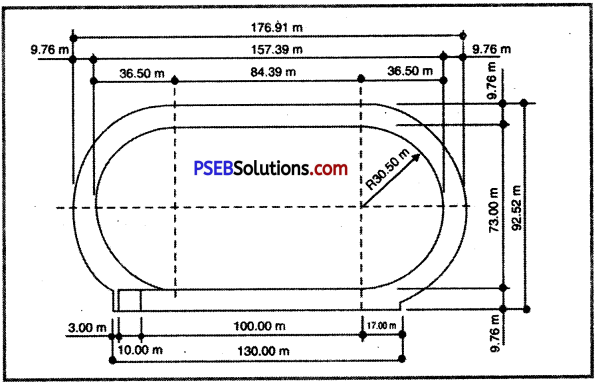
Lane Width:
There are 8 to 10 lanes each 1.22 m wide and no more than 1.25 m. The measurement being taken from the outside edge of one marking line to the outside edge of the next line, going outwards from the track side of the inner kerb. All semicircular curves are equal.
- Line Width: 5 cm (1.97in) wide
- Colour: White
![]()
Competition Area for Track Events:
The Competition area for Track Events includes:
(i) An oval track with at least 8 lanes (400 m+0.04 m x 1.22 m ± 0.01 m) and safety zones measuring not less than 1.00 m on the inside and preferably 1.00 m on the outside.
(ii) Straight with at least 8 lanes (100 m+0.02 m x 1.22 m ± 0.01 m for sprints and 110 m+0.02 m x 1.22 m ± 0.01 m for hurdles)
(iii) Starting area 3 m for 110 m hurdles.
(iv) Steeplechase track as for oval track with a permanent water jump (3.66 m x 3.66 m x 0.50 m- 0.70 m) placed inside or outside the second bend.
Staggers:
When race is running in lanes in the curves then a distance is given for Lanes 2-10 to equal distance for all the running athletes. This distance is known as stagger. It is calculated from the following formula:
Stagger = [w (n-1) -10 cm] 27 C
The data for staggered starts for 400 m Standard Track (constant lane width of 1.22 m) is listed in Table.

Table-Staggered start data for the 400 m Standard Track (in m)
Relay Take Over Zones:
10 m before and after the takeover scratch line in each lane. Before this 10 metres acceleration zone is marked. For the 4 x 400 m relay races, the echelon starting positions for the first athletes in each lane should be marked as shown in the 400 m Standard Track Marking Plan.
The scratch lines of the first take-over zones are the same as the start lines for the 800 m. Each take-over zone’shall be 20 m long of which the scratch line is the centre. The zones shall start and finish at the edges of the zone lines nearest the start line in the running direction. The take-over zones for the second and last take-over is marked 10 m either side of the start/finish line.
The position of hurdles is as per given table:
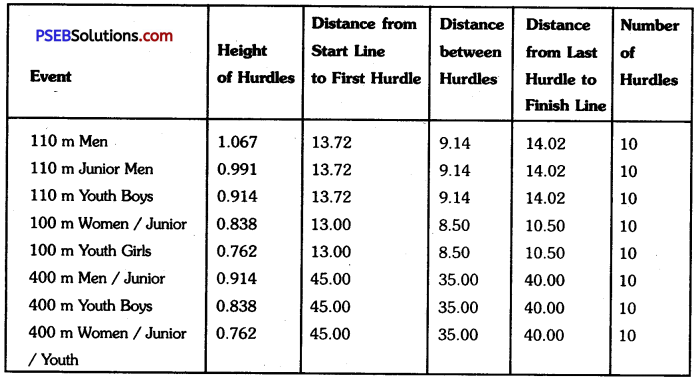
Field Events:
The field events are divided into two following parts:
(i) Jumping events
(ii) Throwing events
Facilities for Jumping Events:
The jumping events are Long Jump, Triple Jump, High Jump and Pole Vault. Their computations are explained below:
Facility for Long Jump:
The Long Jump event includes a runway, a take-off board and a landing area. Preferably the long jump pit is placed outside the track along one of the straights. Two adjacent runways with a landing area at each end are provided to allow competition in either direction by two groups of athletes.simultaneously.
Runway for the Long Jump:
The length of the runway is 40 m min. and is measured from the beginning of the runway to the take-off line. The width of die runway is 1.22 m ± 0.01 m wide.
Take-off Board for the Long Jump:
The take-off board is rectangular and measures 1.22 m ± 0.01 m long, 0.20 m ± 0.002 m wide and not more than 0.10 m deep. It is white coloured. The surface of the take-off board must be in line with the surface of the runway.
Landing Area for the Long Jump:
The landing area must be 7 m to 9 m long and 2.75 m min. wide.

Plasticine Indicator: To detect foul a plasticine indicator is placed. It shall be 0.1 m X 1.22 m and 7 mm in height.
![]()
Facility for Triple Jump:
For triple jump event all the facilities are similar to the long jump but it differs only due placement of the take-off board. For international competition, it is recommended that the take-off board shall not be less than 13 m for men and 11 m for women from the nearer end of the landing area.

Facility for High Jump:
The competition area for high jump includes a semicircular runway, a take-off area, two uprights with cross bar and a landing area. The removing of kerbs makes it possible to use the oval track as part of the runway. For major championships, the high jump facility must be large enough so that two high jumps can be conducted simultaneously. ‘
Runway for the High Jump:
The semicircular runway, with a radius of at least 20 m, will permit approaches from every direction.
Landing Mate for the High Jump:
The landing mat is 6 metre long and 4 metres wide. The overall height is minimum 0.70 metres. It is covered by a spike proof protective mat. It may be placed on a 0.10 m high grid which, on all sides shall be boarded to the ground with its front edge 0.10 m behind that of the mat.
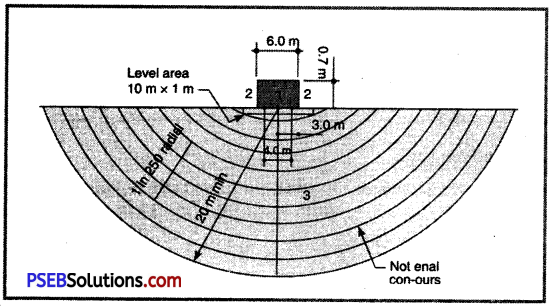
Facility for Pole Vault
The Pole Vault event includes a runway, a box for inserting the pole (vaulting box), two uprights with crossbar and a landing area. It is located either outside the track, parallel to one of the straights or within one of the segments. The facility must provide for two pole vaults to be conducted simultaneously in the same direction, preferably side by side and with same length of the pole vault runway for each.
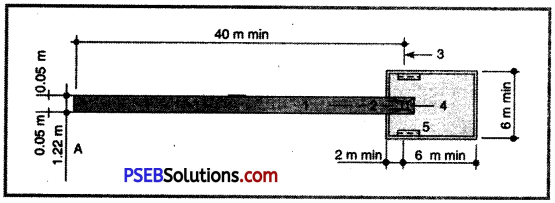
Runway for the pole vault is 40 metres minimum. The runway is 1.22 m ± 0.01 m wide. It is marked by white lines 0.05 m wide. At the end of the runway, the box for vaulting pole is mounted flush with the runway and installed such that the top inside edge of its end board lies on the 0-line and at the same height. The 0-line shall be marked by a white line, 0.01 m wide which extends beyond the outside edges of the uprights.
The dimensions of the box are explained in the figure given below:
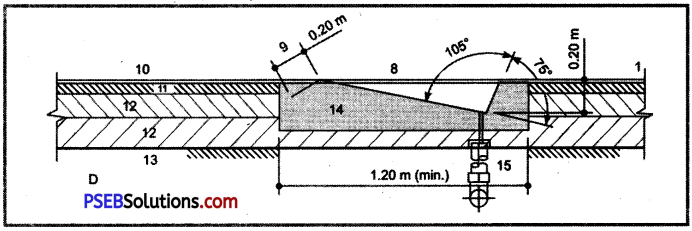
Uprights for the Pole Vault:
The two uprights are installed on horizontal bases, level with the 0-line, such that each can be moved from the 0-line not less than 0.80 m towards the landing area.
![]()
Landing Mats for the Pole Vault
The landing mats for all major international competitions must not be smaller than 6.00 m long (excluding the front pieces used for extra protection) x 6.00 m wide x 0.80 m high. It may be placed on a 0.10 m high grid. The front pieces must be at least 2 m long. The sides of the landing area nearest to the box shall be placed 0.10 m – 0.15 m from the box and shall slope away from the box at an angle of approximately 45°. The figure below explains the dimensions of the landing pit:

Facilities for Throwing Events:
There are four throwing events that are: Shot Put, Discus Throw, Hammer Throw and Javelin Throw.
Facility for Shot Put:
1. Throwing Circle for the Shot Put: The inside diameter of the throwing circle is 2.135 m ± 0.005 m.
2. Stop Board for the Shot Put:
The stop board is made of wood or suitable metal and is painted white. It is placed midway between the sector lines and be firmly fixed to the ground. It is 1.21 m ± 0.01 m long on the inside. The width at the narrowest point is 0.112 m ± 0.002 m and the height is 0.10 m ± 0.002 m measured above the adjoining surface of the circle when the stop board is firmly in position.
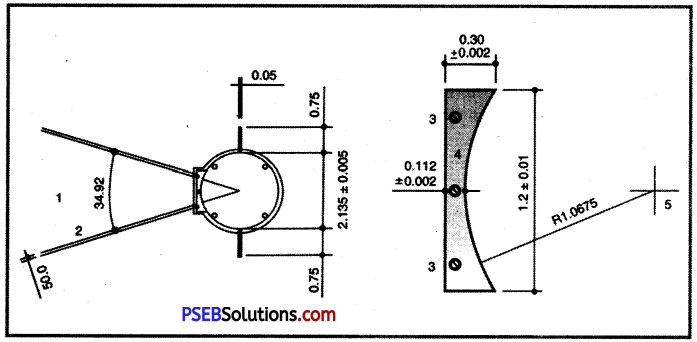
3. Landing Sector for the Shot Put The landing sector is 25 metres long. It has an angle of 34.92 degrees and the computation to draw it is explained in the figure given below:
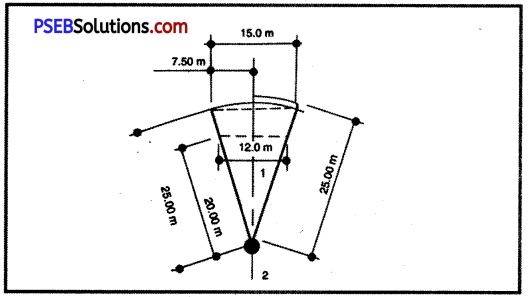
Facility for Discus Throw:
The competition area for throwing events includes Facility for Discus Throw with throwing circle (2.50 m ± 0.005 m diameter), protective cage and landing sector (80 m radius, 48 m chord).
1. Throwing Circle for the Discus Throw:
The throwing circle is made of band iron, steel or other suitable material, the top of which shall be flush with the ground outside or the synthetic surface or concrete surround. The interior of the circle is constructed with concrete and must not be slippery. The surface of the interior is level and 0.02 m ± 0.006 m lower than the upper edge of the rim of the circle. The inside diameter of the circle is 2.50 m ±0.005 m. The rim of the circle is at least 6 mm thick, 70 mm to 80 mm deep and is painted white. The centre of the circle through which all performances are measured is marked.
2. Landing Sector for Discus Throw:
The landing sector consists of grass. The landing sector is laid from the middle of the circle with an angle of 34.92 degrees and is marked by 0.05 m wide white lines. The length of the sector is 80 m.
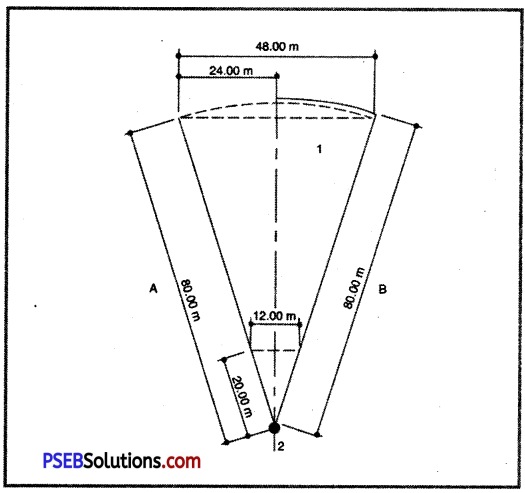
Facility for Hammer Throw:
1. Hammer Throw Circle:
Hammer throw circle is same as shot put circle. However, no stop board is used for hammer throw event.
2. Landing Sector for the Hammer Throw:
The length of the landing sector of hammer throw is 90 metres. It has angle of 34.92 degree.
Safety Cage for Discus Throw and Hammer Throw:
Both the events have safe cage and the dimensions of common cage are explained in the figure given below:
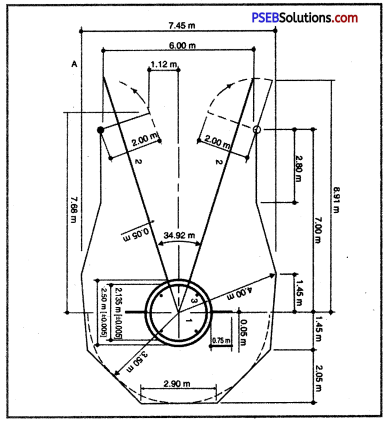
Facility for Javelin Throw:
The facility for javelin throw includes runway (30 m min. x 4 m), arc with a radius of 8 m and landing sector of 100 m radius.
Runway for the Javelin Throw:
The length of the runway is 30 m minimum. It shall be marked by two parallel white lines 0.05 m wide and 4.00 m ± 0.01 m apart. Two white square marks 0.05 m x 0.05 m beside the runway four metres back from the end points of the throwing arcs.
![]()
Throwing Arc for the Javelin Throw:
The throwing arc is situated at the end of the runway. It may be painted white and is made of suitable non-corrodible material like hard plastic. The throwing arc is 0.07 m wide and is
curved with a radius of 8.00 m from the centre point in the middle of the runway. The detailed specifications are explained in figure given below:
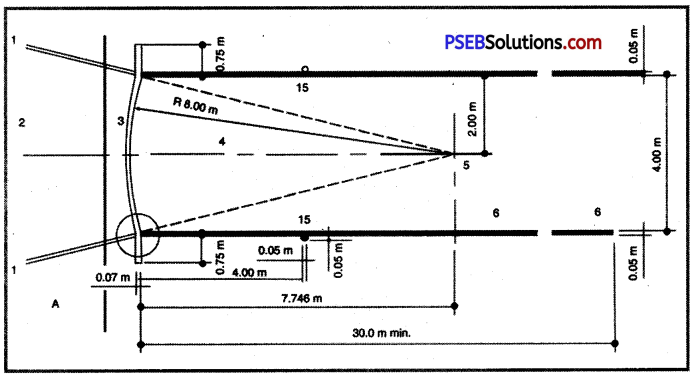
Landing Sector for the Javelin Throw:
The landing sector is 100 metres long. The computation of the marking of landing sector is explained in figure given below:
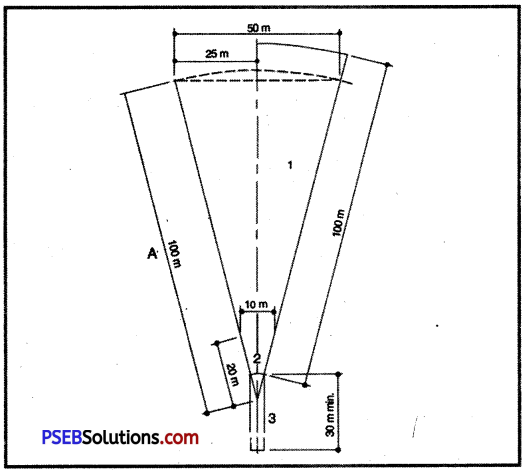
The placements of all the events is explained in the figure given below:
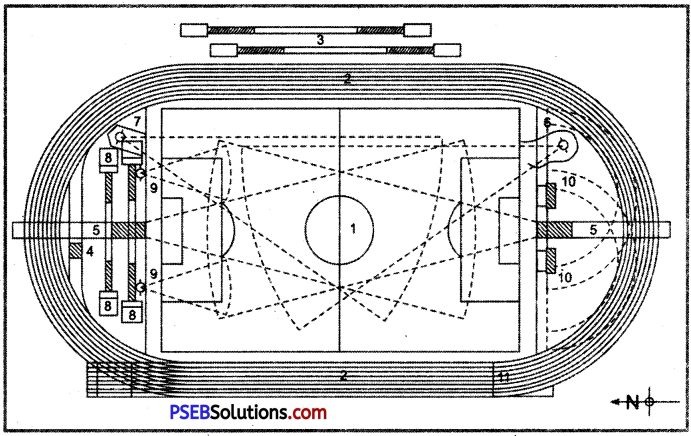
![]()
Athletics Games Important Questions
Question 1.
Enlist various short distance races.
Answer:
100 m, 200 m and 400 m, 100 m HR (w) 110 m HR (M) 4 x 100 m Relay, 4 x 400 m Relay.
Question 2.
Where were the First Modem Olympic Games was organized?
Answer:
Athens in 1896.
Question 3.
Name the field events in Athletics.
Answer:
Jumping events and Throwing events.
Question 4.
How many judges are required for field event?
Answer:
03 (or more).
Question 5.
What is the distance of straights in track?
Answer:
84.39 m.
Question 6.
How many lanes are there in standard track?
Answer:
8 lanes.
![]()
Question 7.
What is the formula for calculating staggers?
Answer:
[w (n – 1)-10 cm] 2n
Question 8.
What is the distance of staggers for 800 m race for 2nd lane?
Answer:
3.52 m.
Question 9.
What is the height of hurdle for 110 m?
Answer:
1.067 m.
Question 10.
Write the diameter of Shot Put circle for men.
Answer:
110-130 m.
Question 11.
What is the weight of Shot Put for women?
Answer:
4.005 – 4.025 kg.
Question 12.
Give the length of Javelin for men.
Answer:
260-270 cm.
Question 13.
What is the diameter of shaft for men?
Answer:
25-30 mm.
Question 14.
What should be the width of landing area in long jump?
Answer:
2.75 m.
![]()
Question 15.
Name the types of start in track event.
Answer:
Bunch/Bullet start, Medium start and Elongated start.
Punjab State Board PSEB 12th Class Physical Education Book Solutions 12th Class Physical Education Practical Athletics Important Notes, Questions and Answers.